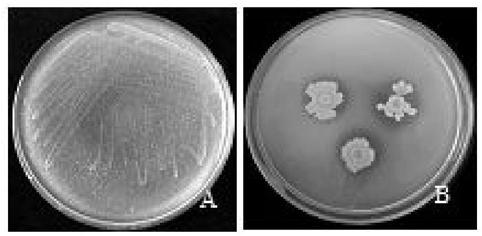Forest tree rhizosphere bacteria Bacillus paramycoides JYZ-SD5 and application thereof
A technology of JYZ-SD5 and Bacillus mycoides, applied in the field of microorganisms, can solve the problem that the comprehensive performance of PGPR is relatively less studied.
- Summary
- Abstract
- Description
- Claims
- Application Information
AI Technical Summary
Problems solved by technology
Method used
Image
Examples
Embodiment 1
[0031] The bacterium JYZ-SD5 isolated from the rhizosphere of poplar in Shandong is preserved in the China Center for Type Culture Collection with the preservation number: CCTCC NO: M2018469.
[0032] 1) Physiological and biochemical measurements of the bacterial strain JYZ-SD5 were performed referring to the "Bergery Bacteria Identification Handbook" and "Common Bacterial System Identification Handbook" to describe the colony morphology and characteristics.
[0033] The colony of the strain JYZ-SD5 on the NA medium is nearly round, with irregular edges, milky white, no protrusion in the middle of the colony, moist and shiny ( figure 1 A, B). The bacterium is short rod-shaped, without flagella, Gram-positive bacteria, and green spores can be seen in the spore staining observation, indicating that spores are produced ( figure 1 C).
[0034] Strain JYZ-SD5 was positive in VP test, methyl red test, indole test and nitric acid reduction test, and could hydrolyze starch and gelat...
Embodiment 2
[0042] Example 2 Rhizobacteria JYZ-SD5 Nitrogen Fixation, Phosphorus Solution, Potassium Solution Performance Measurement
[0043] 1) Detection of nitrogen fixation characteristics: Inoculate the tested strains in nitrogen-free medium by streaking on a plate, repeat each treatment 3 times, place them in a low-temperature constant temperature incubator (MIR-553, Japan) at 28°C, and observe the bacteria continuously growth status.
[0044] 2) Detection of organophosphate-dissolving characteristics: inoculate the tested strains in the organophosphate-dissolving medium by three-point inoculation method, repeat each treatment 3 times, place them in an incubator at 28°C, and continuously observe the density of the transparent circle around the colony. Yes or no.
[0045] 3) Determination of potassium decomposing ability: adopt the method of liquid culture to inoculate the test strain into the liquid medium for detecting potassium decomposing, repeat each treatment 3 times, place it...
Embodiment 3
[0049] Example 3 Rhizobacteria JYZ-SD5 produces IAA ability detection
[0050] 1) Qualitative detection: Pick a single colony and insert it into King's medium B, incubate in a constant temperature shaker (MultitronStandard, Switzerland) at 37°C for 24 hours, use a sterile pipette tip to draw 1mL of bacterial liquid into a sterile centrifuge tube, add 4mL of Sackowcki's After the developer was mixed quickly and fully, the color was developed at room temperature for 40 minutes in the dark, and the color change was observed.
[0051] 2) Quantitative detection: Accurately weigh 10mg of IAA, first dissolve it with a small amount of ethanol, then dilute to 100mL with distilled water (concentration is 100μg / mL), and then dilute to 0, 4, 8, 12, 16, 20, 24μg / mL respectively , take 1mL of each concentration, add 4mL color reagent respectively, keep dark at 40°C for 40min, measure OD value at OD535, and draw a standard curve. Centrifuge the cultured bacterial suspension and the blank co...
PUM
| Property | Measurement | Unit |
|---|---|---|
| tolerance concentration | aaaaa | aaaaa |
Abstract
Description
Claims
Application Information
 Login to View More
Login to View More - R&D
- Intellectual Property
- Life Sciences
- Materials
- Tech Scout
- Unparalleled Data Quality
- Higher Quality Content
- 60% Fewer Hallucinations
Browse by: Latest US Patents, China's latest patents, Technical Efficacy Thesaurus, Application Domain, Technology Topic, Popular Technical Reports.
© 2025 PatSnap. All rights reserved.Legal|Privacy policy|Modern Slavery Act Transparency Statement|Sitemap|About US| Contact US: help@patsnap.com



